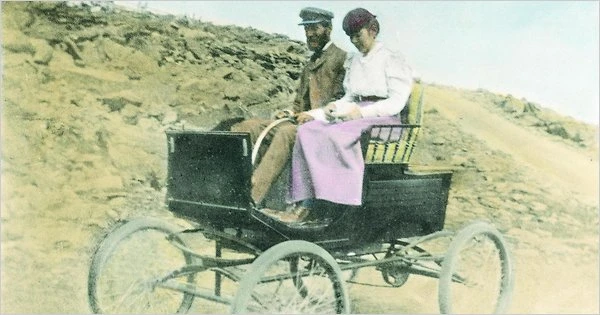The Stanley Steamer
Now that electric cars are becoming more popular, and there’s talk about hydrogen fuel cell vehicles, our attention has been turned to what’s powering our cars. In this context, it’s interesting to one of the solutions used in the past as an alternative to petrol or diesel power: steam.

A good friend of mine, during a discussion on fuels, EVs and similar topics, wondered whether steam could be used to drive a car. I was sceptical, but it turns out that I was wrong. A little over 100 years ago, steam-powered cars were indeed a thing. They aren’t just a steampunk fantasy, as I had thought.
One of the most popular type of steam-powered cars was invented by the Stanley twins in the USA at the end of the 19th century. Bizarrely, F.E. and F.O. Stanley also invented one of the first photographic airbrushes, as they started their business ventures in the area of photography. However, automobiles were a lot more interesting, and they started the Stanley Motor Company in 1902 after an earlier attempt with a company known as Locomobile.
At that time, many internal combustion engines that ran on petrol or diesel needed a crank to start them up. These cranks were tough to turn and required a fair bit of elbow grease. They could even be dangerous, as if the car backfired while someone was cranking it, this could leave the person doing the cranking with a broken arm. However, the Stanley Steamers used gasoline (petrol) to generate a good head of steam, which provided the power to turn the wheels, and they didn’t need cranking. Stanley Steamers were designed with safety in mind, as they had a system in place to prevent the boiler from exploding if too much heat and pressure was generated.
For its time, the Stanley Steamer had some fairly impressive specs. It was a rear wheel drive affair, and didn’t require a transmission or clutch system, meaning that they were easier to drive. The power output varied depending on the engine type. The basic model (the compact engine) could deliver 7.5 kW. Two twin-cylinder engines were developed, the smaller one (3¼-inch bore and 4¼-inch stroke) also put out 7.5 kW, but the larger one (4-inch bore and 5-inch stroke) delivered a massive 15 kW.
For its time, the Stanley Steamer was quite fast. In fact, a customised version of the Stanley Steamer known as the Stanley Rocket Racer became the holder of the world land speed record for automobiles over a mile, clocking up 204 km/h in a trial at Daytona. This record stood for five years, and remained the best time over a mile for a steam-powered car until 2009.
As time went by, the Stanley twins refined their design, switching to lightweight aluminium bodywork and features such as condensers that harvested the steam so that the range of the water tank could be extended.
However, the makers of cars with internal combustion engines managed to find an alternative to the crank: the electric starter motor. This meant that the drawbacks of cranks were no longer, and the Stanley Steamer lost its biggest attraction, especially with the rise of cars produced via mass production and sold cheaply, Ford being the best known example of these. The Model T cost less than a quarter of the price of the Stanley Steamer and the engine of even the base model, which ran on petrol, kerosene or ethanol (now, that’s an idea worth revisiting), had the same power output as the best of the “Flying Teapots”, as the Steamers were known.
Given the stiff competition from the internal combustion engines inside the Model T and similar vehicles, things didn’t look good for the Stanley Steamer. Eventually, after one of the twins died (in a car crash, of all things), the company went under, ultimately closing in 1924.
The Stanley Steamer wasn’t the only steam-powered car in existence. Others have been made and sold, especially the Doble, and the idea has come back now and again over the past century or so, especially given concerns over pollution and the availability of fuel. Saab had a go at making a steam car in the 1970s during the fuel crisis of that decade (the project failed, unfortunately). An Australian inventor and enthusiast named Ted Pritchard tried to develop one in the 1960s and beyond and had some success. Until he died in the early 2000s, he was pushing for the use of steam-powered cars.
External combustion engines (which is what a steam engine is) aren’t as efficient as ICEs but they produce a lot less pollution, as they don’t burn as much fuel. They are heavy, thanks to the need for a strong boiler and a water tank. They can accelerate quickly once they’ve got a good head of steam up, but they do need a fair bit of time to boil and let the pressure build; this is one of the things that experimenters wanting to bring back the steam car try to work on.
And what about the future? Given the push towards vehicles that are less dependent on petrol and diesel, will we see attempts to make the steam car come back again? Electric cars have made a comeback (and how!), so perhaps steam will do the same.